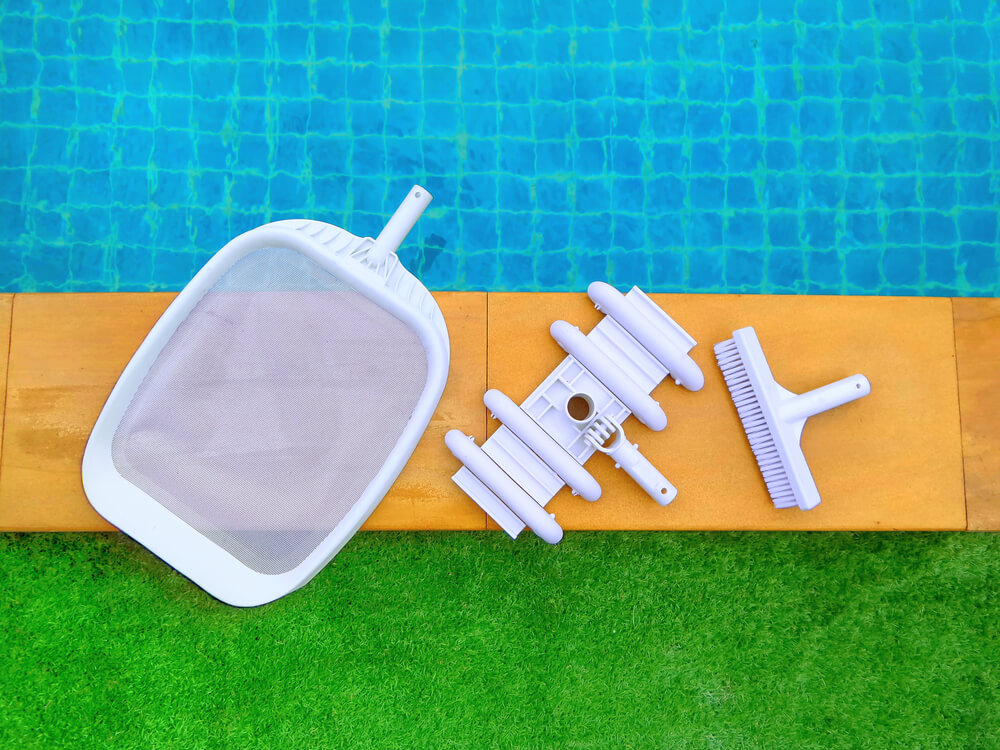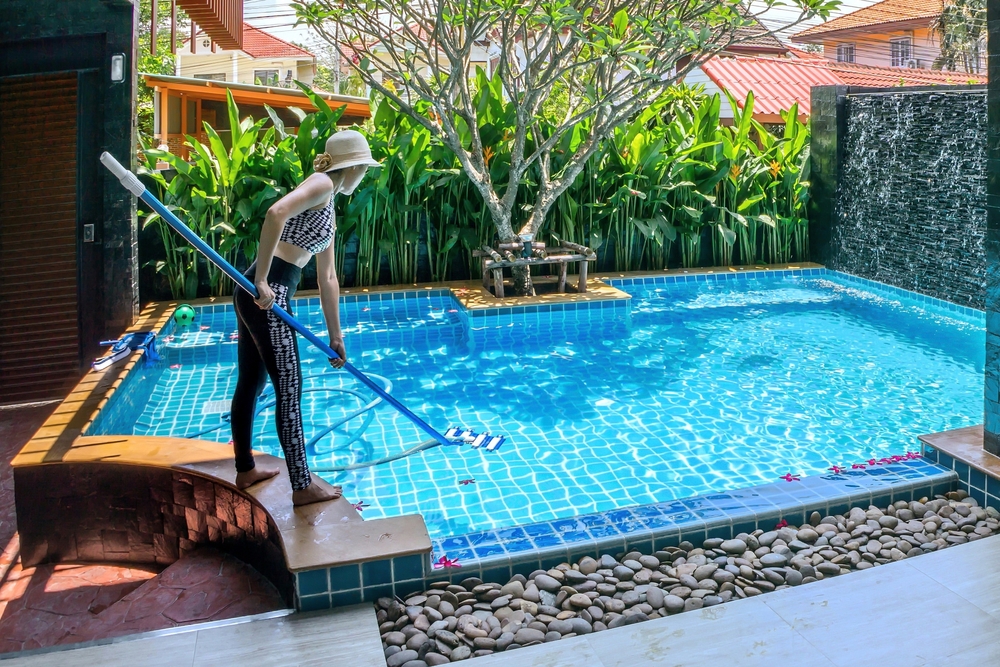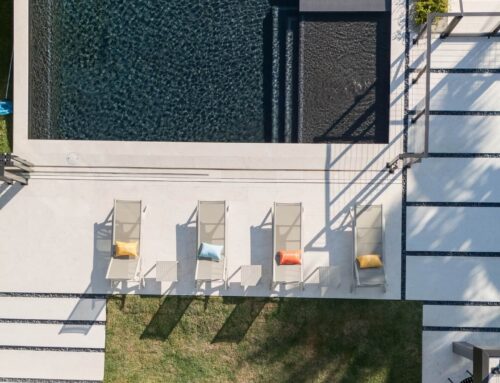Giving your pool the right kind of care will not only keep it in good shape but will also make your wallet happy. Sure, you could spring for professional swimming pool cleaning services, but brushing your own pool will save you money and give you a bit of a workout to boot.
And the best part?
Brushing your pool is super simple. You can be done in as little as 10 minutes once you’ve got the technique down. In this article, we’re going to teach you how to brush efficiently, what brushes to use, and how often you need to brush your pool.
Know Your Brushes
Before you get your hands dirty, so to speak, it’s worth spending a little time getting acquainted with the tools for the job.
There are three types of pool brushes in terms of the bristle material they use — nylon, bristle, and stainless steel.
Nylon brushes are the most common. Nylon is a resilient material, and it’s soft enough to where it will never harm your pool’s surface. It’s the most appropriate type of brush for frequent brushing.
Bristle brushes technically use a combination of nylon and natural bristle. They’re a little stiffer and more aggressive. If algae start to creep up rather quickly, you may need to use a bristle brush to scrape it off effectively. However, you probably shouldn’t use a bristle brush for your regular cleaning.
Lastly, stainless steel brushes are the most aggressive and abrasive. You should reserve the stainless steel brush for severe algal blooms or stains that you can’t scrub out any other way. If you have a concrete pool, a stainless steel brush will scrape off your plaster coat, so use it as sparingly as possible.
The most common brush size is 18” wide, and that is entirely appropriate for most pools. However, you can also get larger brushes of up to 36” if you have a lot of ground to cover, and you need to do it fast.
Typically, you’ll need to replace your nylon brush every four to five years. A stainless steel brush will last you a lifetime with proper care. To get the most use out of nylon brushes (and most pool equipment), keep them away from direct sunlight and harsh chemicals. UV rays degrade the nylon bristles and make them brittle.

How To Brush A Swimming Pool
There’s not too much to learn about the actual brushing process. Your goal is to scrub the entire surface of the pool. But applying the right technique will make your brushing both easier and more effective.
Before you start brushing, it’s a good idea to develop a pattern you’ll follow. This can be a classic back and forth, concentric circles, or whatever is most comfortable. The purpose of the pattern is not to miss any parts while you’re brushing. Often, algae won’t be present enough to give you visual cues about where you’ve brushed.
Once you’ve got the pattern, you generally want to start from the stairs. Stairs are the area that receives the least attention from your pump. Therefore, they need the most attention from your brush.
Scrub them first, always pushing the brush and never pulling. As much as possible, you want to always brush towards your pool drain. Whatever you remove from the surface should be pushed out of the pool, not allowed to settle back down.
When the stairs are done, brush the walls of your pool. Let the brush handle slide through your guide hand as you push it from the top with your other hand. Put the brush against the wall, brush downward with force, and then lift the brush out without touching the wall.
Once the walls are done, brush the bottom of the pool. Again, you always want to brush toward the drain and use smooth motions. Avoid short strokes since they make it easy to miss parts of the pool. Go for long, smooth brush strokes and follow through as far as you can on each stroke.
Although it won’t take very long, brushing your pool will be challenging at first. You’ll soon develop the arm stamina to brush without much effort, but getting there will take some time.
When to Brush a Pool and How Often
There’s no universal pool brushing schedule you need to stick to. Rather, certain events will call for more or less brushing.
You shouldn’t need to brush a typical pool with a working pump more than twice a week. That’s a good number to avoid needless effort and keep your pool in good shape. In times of severe algal growth, you may need to increase that number to three times a week, but that’s pretty rare and may mean your chemicals need to be adjusted.
After a swimming pool installation, or when it is replastered, you’ll want to brush much more often. Brush it twice a day for the first two weeks and then move to a standard schedule.
Every time you add chemicals to fix the pool’s balance, it’s important to brush it. It helps the chemicals dissolve evenly.
If your pool pump isn’t working, you’ve got your work cut out for you. You’ll need to brush not only to prevent algal growth but also to prevent stagnation. Brush your pool twice a day thoroughly until your pump is in working order.

Why Brush Your Swimming Pool?
Brushing serves several purposes. First and foremost, it helps prevent algal growth. If you don’t brush your pool regularly, algae will start growing on the surface. Chemicals can avoid a lot of algal growth, but you’d need dangerous amounts to curtail the spread of algae entirely.
Brushing also prevents scale buildup on your pool’s surface. Particles that settle on the bottom eventually build up into hard layers that are difficult to remove if left unchecked. Regular scrubbing never allows these particles to bunch up and become a problem.
Lastly, it prevents etching. The chemicals used in pool maintenance are rather harsh and will gradually deteriorate the pool’s inner surface. Brushing regularly slows this process down considerably. You may get up to several more years of use out of your pool if you scrub it regularly.
A Good Brushing Keeps Your Pool Happy
As you can see, brushing your pool isn’t at all elaborate or complicated. It’s good to have all your bases covered, but a quality nylon brush is likely all you’ll need for a typical pool that’s brushed often.
You’ll need to brush your pool more frequently in some situations. For instance, if you just had a concrete pool replastered, or you’re adjusting the chemicals in the pool. Otherwise, twice a week is a good rule of thumb.
If you need more help figuring out how to brush your pool or you’d like us to give you personalized tips, leave us a comment below right now. We’re passionate about pools, and we’d be happy to help you.
And if you’re looking for the best pool installation Miami has to offer; we’re always ready to give you a free estimate. Give us a call today!






